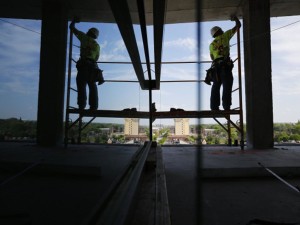By: Jamie Fettkether
President, Construction
One would think that after millions of layoffs during the Great Recession that there would be plenty of workers available to meet the growing demand for construction. But the opposite is true.
The industry is facing a shortage of available workers at a time when construction demand is exploding. The number of unemployed construction workers is at a 14-year low, according to federal employment data released by the Associated General Contractors of America. Construction employment expanded in 249 of our 358 metro areas, between March 2014 and March 2015. The AGC also reported that 83 percent of contractors are struggling to find enough qualified skilled labor.
Many of the workers who lost their jobs during the economic downturn either switched careers or retired. The industry hasn’t recruited and trained near enough new workers to replace those lost, and the situation likely won’t improve anytime soon.
According to the U.S. Census Bureau’s 2012 Current Population Survey, roughly 44 percent of the construction workforce is 45 years of age or older and nearly one out of every five construction workers is 55 or older. That means a minimum of 1.1 million construction workers will likely retire within 10 years.
The labor shortage has many implications including rising insurance rates due increased worker injuries, increased project defects, and most notably, delays in completing projects. In addition to finding workers, the construction industry is also dealing with increased employment regulation.
Construction companies working on federal projects must comply with several recently passed mandates, including The Fair Pay and Safe Workplaces executive order. This mandate requires contractors to disclose during the bid process if they have committed labor law violations in the previous three years.
Other recent mandates for construction companies bidding on federal contracts include:
- A minimum wage
- Affirmative action for veterans and individuals with disabilities
- Nondiscrimination for sexual orientation and gender identity
- Equal pay reporting
- Pay transparency
Another new rule affecting the construction industry is the National Labor Relations Board’s “quickie election” rule, which went into affect in April. The key part of the rule is that it shortens the time between a union’s filing of a petition and the holding of pre-election hearings, thus making it easier to organize. The rule also limits the employers opportunity to communicate with workers prior to an election vote.
A concern that the AGC has expressed with the rule is that most unions may use the changes to organize open-shop contractors and to convert union contractors from 8(f) to 9(a) relationships.
Another labor issue that potentially threatens the construction industry is the redefining of who is an employer. The NLRB ruled last year that McDonald’s is jointly liable for the employment actions of its franchisees. Labor groups want to take this ruling a step further. The Teamsters union has asked the NLRB to declare Browning-Ferris, a recycling company in California, a joint employer with the staffing agency that employers workers for the company’s recycling plant. If successful, construction industry experts worry that it could lead to contractors being held responsible for the working conditions of their subcontractors.

